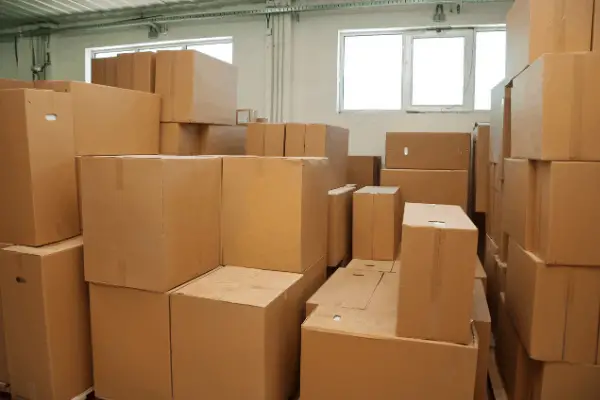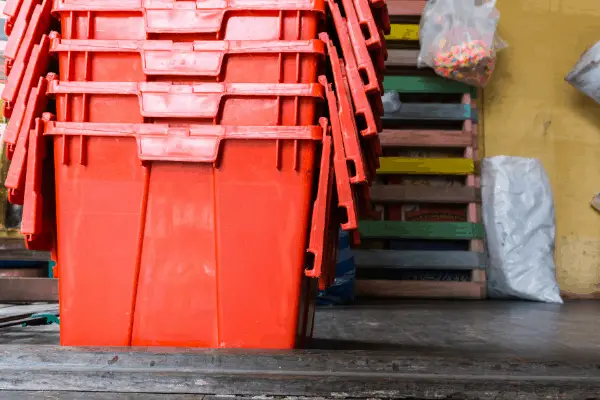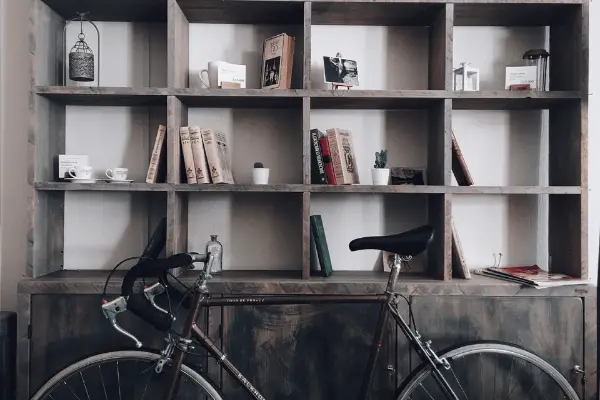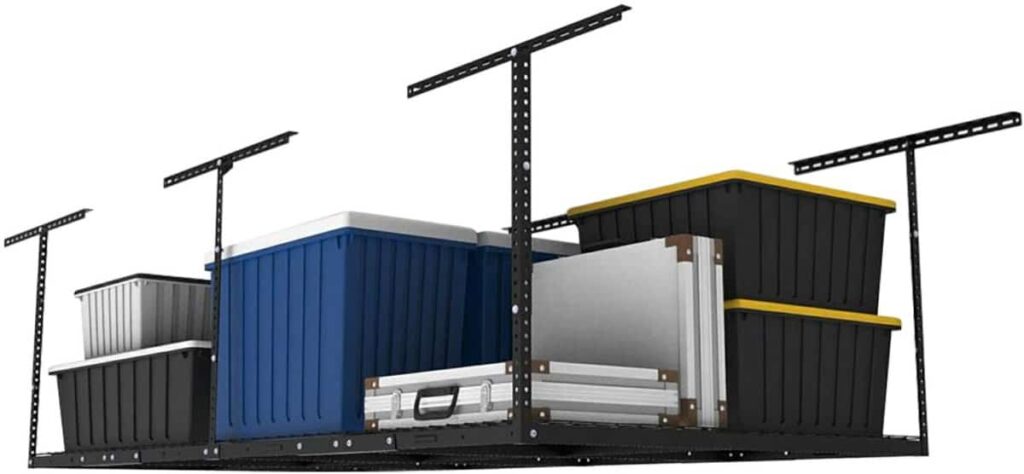If you’re pondering how to store books in your garage, you are part of the 65% of adults in the United States who prefer to read print books versus e-books or listen to audiobooks. And if you’re like the average American, you’re reading at least 12 books a year, which means you may be eyeing your garage for book storage. But there are several things to consider before you place your books in the garage.
Storing books in a garage involves picking the right containers, installing stable shelving, avoiding direct sunlight, controlling humidity levels, implementing a plan to keep pests away, and setting a reminder to check on your books once in a while.
If the garage is your best option when it comes to storing your most-loved classics, then following this complete guide will ensure your books have a long, damage-free storage life.
The Garage Environment
Each of the steps we’re going to discuss is crucial when it comes to extending the life of your books.
Even if your garage is attached to your house and receives the benefits from your central heating and air, the fluctuating temperatures and humidity can still cause some severe damage.
You need to start with the right kind of storage.
Picking the Right Containers
Depending on your garage storage situation and how many books you have, there are three different options when it comes to containers:
- Cardboard boxes
- Plastic boxes
- Choosing no boxes at all
But which one is the best when it comes to preventing damage to your books?
Cardboard Boxes for Storing Books in a Garage
The good-old cardboard box can be perfectly fine for storing your books in the garage. However, make sure you select a cardboard box that wasn’t used to store food.

Any leftover crumbs or even residue you can’t necessarily see can attract bugs and mice.
Another critical factor to keep in mind is that closing up your books in cardboard boxes does increase the chances of the books collecting mold because you’re limiting the airflow.
So, if you store your books in cardboard boxes, be sure to let your books breathe every few months.
Plastic Containers for Storing Books in a Garage
The next option for storing books in a garage is placing your books in weatherproof and moisture-proof plastic containers.

Again, it’s essential to make sure the plastic containers weren’t used for storing any food to avoid attracting pests.
The good news with plastic containers is that they come in a variety of shapes and sizes. The bad news is, again, you’re cutting off the airflow to your books, and if you place the plastic container in direct sunlight, the effect is just like leaving your books outside on the sunniest summer day.
The Best Option: Using No Containers For Storing Books in a Garage
That leaves the last option, which is using no cardboard boxes or plastic containers for storing your books.
It may seem odd or unsafe not to place your books in some type of box or container, but airflow is crucial when it comes to preventing damage to your books.

So if you’re able to place your books on shelving in the garage, that is the best option. But it is also critical to follow these steps when placing your books on shelves to prevent any possible damage to their structures and spines:
- Keep the same size books together and line them up side-by-side. If a tall book is placed next to a short book, this could cause the books to warp.
- Don’t let the books lean or tilt on the shelves.
- Don’t store them too tightly or too loosely.
- When you want to remove the book from the shelf, do not pull it from the top of the spine. It would be best to push the other books away and grab the book you want from the middle.
But What If I Need To Use Boxes Or Containers?
If limited space availability prevents you from keeping your books freestanding on shelves in the garage, and you have to use containers for storage, there are some easy-to-follow steps to help your books survive storage.
- Make sure containers are moisture-proof and weatherproof.
- Store the same sized books together.
- Lie the books flat or standing upright with the paper edges facing upward.
- Do not stand the books on their spines. This causes damage over time.
- Put the heaviest books on the bottom.
- Tightly pack the paperback books.
- You can also wrap your books with acid-free archival paper for some added protection.
- Seal the boxes with acid-free packing tape.
- Don’t forget to label the boxes or containers, so you know what’s inside.
- Keep the boxes or containers away from direct sunlight.
- If you can, place the boxes and containers on shelves in case of any leaks or flooding.
Installing Stable Shelving
Since letting your books stand freely on shelving is the best option, it’s vital that you install stable shelving in your garage. There are so many options now to turn your garage into a safe storage place for books, and you can easily install the shelves yourself or hire a professional.
One popular option is installing some of these overhead garage storage racks (link to Amazon).
This could be a great option if you decide to keep your books out in the open or in boxes or containers, and you don’t have the space to place shelves against the walls.
These shelves actually hang from the ceiling, allowing you to utilize space that usually goes unused.
No matter what kind of shelving you install, it’s essential to make the shelves are stable because you don’t want books falling from the storage area. It could cause serious damage or perhaps go unnoticed for an extended period of time.
Additionally, rust-proof metal is ideal to avoid any future damage to the books.
Avoiding Direct Sunlight
If your books are out in the open or in boxes or containers, one of the most critical steps is keeping your books away from direct sunlight.
Too much sun causes damage to our skin; the same goes for your books!
The UV rays in sunlight are terrible for books because it triggers chemical changes to the paper, not to mention the chemicals the leather or cloth your on books may have. As a result:
- The paper becomes bleached
- The paper turns to that familiar yellow or brown color we’ve all seen with old books
- The leather or fabric fades
- The spine suffers the most damage because it’s the most exposed part of the book
As a result, direct sunlight exposure will cause the pages of your books to become so weak and brittle they will deteriorate. Even if you remove the books from the sunlight, the UV rays they had been exposed to continue to do their damage!
Controlling Humidity Levels
The best storage place for books is cool but also dry.
The garage can definitely be a cooler place compared to other parts of the house, particularly in the fall and winter, but it also accumulates way more moisture.
Moisture is kryptonite for books. Once it takes hold, you’re going to end up with chapters filled with mold and fungus.
Garages have more humidity for many reasons.
Weather plays a significant factor, from fluctuating temperatures between winter and spring, plus condensation from rainwater and melting snow.
Additionally, running appliances in the garage without the right ventilation will cause additional moisture to build up.
The best scenario is to keep humidity levels below 25% in the garage. If that goal is not possible, humidity below 50-60% should be OK for most books.
As the following table will show, there are a variety of ways you can control the humidity levels in your garage:
| Install a heater | This will help keep your garage warm during the cold months and help maintain a stable temperature in the garage. |
| Install a vapor barrier or insulation | Using this inside your garage walls is a great way to reduce moisture. |
| Dry off your vehicle | Ensuring your vehicle is dry before parking it in the garage can help reduce the amount of moisture that builds up. |
| Consider applying an epoxy floor coating | Applying an epoxy coating to your garage floor not only protects the floor from normal wear and tear but helps prevent condensation. |
| Place a dehumidifier in the garage | This is a quick and easy way to reduce condensation. Just don’t forget to empty the water from the collection tank. |
Implementing a Plan to Keep Pests Away
Keeping pests away from your books is something you need to plan for, and you definitely have to think beyond just mice.
There are actually several different types of pests who would love to devour a good book. Literally.
| Pest | Damage Caused to Books | How to Keep Them Away |
| Silverfish | They love eating the glue and paper from books | Check for any leaky plumbingKeep humidity levels below 50% If you’re using containers, make sure they are free of any food residue Sprinkle boric acid around crevices, cracks, and bookshelves. |
| Cockroaches | Not only do they eat the paper and the binding, but they also leave behind a not-so-pleasant gift of brown liquid on your pages | Try to look for any possible cracks or openings and make sure to fill them in with tape or caulk Fix any leaks.Spray the outside of the garage with a residual insecticide every 60-90 days. |
| Booklice | Yes, there are booklice, and they are not only attracted to the yummy pages of your books, but they love high humidity. | Keep humidity levels below 50% in the garage. If this is not possible, you may need to call a professional pest control expert. |
| Mice | Mice love to eat paper | One natural way is to soak cotton balls with peppermint and place them around books. Mice do not like the scent and should keep them away. Another possible solution is to soak cotton balls with pest repellent. Using cotton balls is a safer option, as you don’t want to spray the repellent on your books. |
What to Do if You Suspect Pests Have Invaded
If you think perhaps some pests have already infested your books, the first thing to do is remove the infected books from the collection.
If you think the pests might still be in the book, you can place the book in a plastic bag and place it in the freezer. This will definitely kill any pests that may have still been inside your book(s).
If the pests did cause some damage to your books, perhaps they munched on the edges of the paper or the binding, the best thing to do is to talk to a professional bookbinder. They would be able to recommend the best way to restore the book.
Check On Your Books in the Garage
It will feel amazing once you have all your books packed up or stacked neatly on your freshly installed shelves, and you hear the buzz of the dehumidifier in the background.
Even if you took all the precautions to make sure your books are safely in storage, it’s also highly recommended you take a peek at them once in a while.
If you choose to stack your books on shelves instead of using containers, it’s a good idea to dust them about once a month. This prevents dust from collecting in the little cracks of the pages.

You can use a vacuum, but make sure to use the soft brush attachment, so you don’t accidentally suck away pages from your book.
It’s also a good idea to check your books occasionally just to be sure mold isn’t growing, or any of those pests still made their way to your collection.
Again, if you notice any damage, it’s crucial that you isolate the effected books from the others, and depending on the damage, take the appropriate next steps.
If it looks like a mold or pest problem has cropped up, try adjusting the dehumidifier. If your books are significantly damaged, seek a professional who can provide recommendations on restoring your precious books.
It may seem counterintuitive to place your books in storage, only to have to remind yourself to check on them once a month. But if you catch any possible issues right away, it will save you a ton of headaches in the long run.
You can make checking on your books’ health part of your monthly cleaning routine; take a peek just to make sure your books are doing OK.
Other Places to Store Books in Your Home
If you only have so much space in the garage and you’re still seeking more storage space for your books, there are actually a few places around your house that you can convert into book storage. Here are some inspiring examples:
- Hallway library: Adding some shelving to the walls of your hallway can help not only free up space, but it can also help connect your rooms.
- Bookshelf cubes: Cube organizers (link to Amazon) not only create storage space, but they are also multi-functional and customizable.
- Floating bookshelves: These shelves are a great way to organize clutter, and again, there are so many options available.
- Custom bookshelf around a doorway: This option is great if you’re looking for a unique home project. Not only do you create a space for storage, but also you add a fun accent to a doorway.
- The Bookshelf Door: Another fun DYI project for the weekend, you not only have another bookshelf, but you just created a hidden passageway to a secret room!
- Under Benches: Bench seating (link to Amazon) is a trending option for homes, so placing your books under or inside of benches is another great option.
- Under the bed: Another possible place for storage that often goes unused. Finding some containers with wheels can be an easy way to store your books and easily roll them out when you need them.
- Above the headboard: Another area that often goes unused; you can transform the space above your headboard to the library of your choice.
Final Tips for Creating an At-Home Library
With a little imagination and taking the proper steps, you can turn any space in your home into a library.
Regardless of where you place your books, one major don’t is wrapping your books in plastic wrap or foil. This is a significant, do not!
It doesn’t matter if the books are in containers or free standing on shelves. It may seem like added protection, but plastic wrap and foil actually keep moisture in and accelerate the growth of mold.
If you have a valuable book and want to make sure you keep it in the absolute best condition, you should invest in a dust jacket.
There are several choices available, and it may take some trial and error to figure out which one is the best fit for your book.
Dust jackets are a great way to block pests and moisture. Most people choose a dust jacket for books they hope to sell someday. But if you want to ensure the best protection for your favorite book, no matter the book value, a dust jacket is a great choice.
Just remember, no matter where you store your books, the best option is to keep them in a place that is shaded, cool, dry, not subject to temperature changes, and free of pests.


